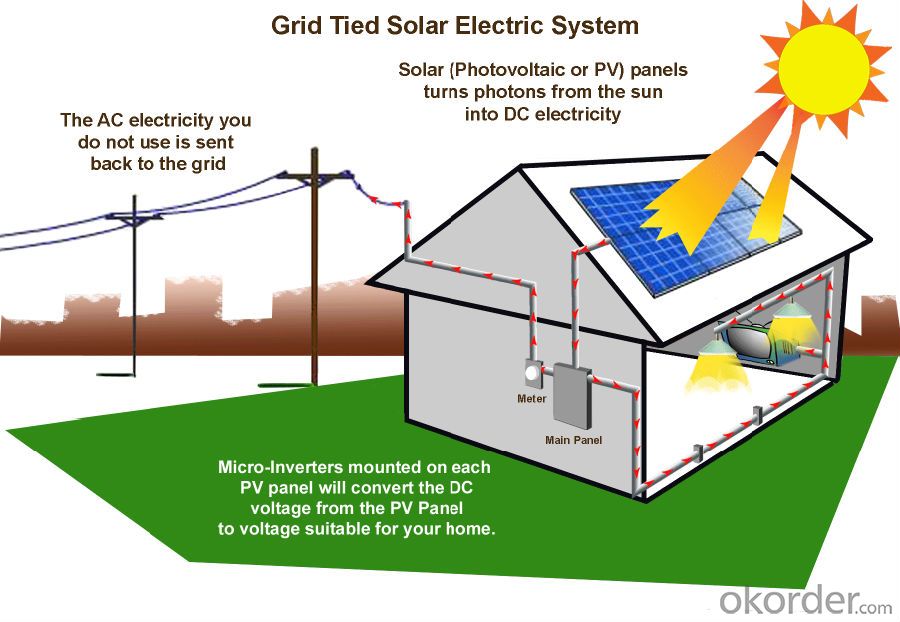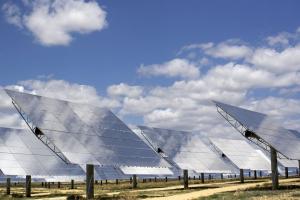Solar Panel Solar Module PV Solar With A Grade 290W
- Loading Port:
- Shanghai
- Payment Terms:
- TT OR LC
- Min Order Qty:
- 1 watt
- Supply Capability:
- 10000000 watt/month
OKorder Service Pledge
OKorder Financial Service
You Might Also Like
Item specifice
Solar panel material
1. glass
Its main role is to protect the power generation ( solar cells ) , there is a selection of light transmittance requirements : 1 ) must be high transmittance (typically 91% or more ) ; 2 ) super white steel processing.
2. EVA
For bonding glass and power generation fixed body ( such as cells ) , transparent EVA material directly affect the life of components exposed to the air EVA prone aging yellow , thus affecting the transmittance components , thus affecting in addition to generating the quality of the components itself, the quality EVA lamination process on the component manufacturers is also very large, such as EVA plastic viscosity of non-compliance , EVA and glass, back bonding strength is not enough, can cause premature aging EVA, the affected component life.
3. Solar cells
The main role is to generate electricity , the electricity is the main market mainstream film crystalline silicon solar cells , thin-film solar cells , both have their advantages and disadvantages . Crystalline silicon solar cells , the equipment costs are relatively low , but the high cost of consumption and cells , photoelectric conversion efficiency is high, the next generation in outdoor sunlight is more appropriate ; higher thin-film solar cells , the relative cost of equipment , but the cost of consumption and battery low, relatively low photoelectric conversion efficiency of crystalline silicon solar cells , but the effect is very good low-light , in the ordinary light can also generate electricity , such as solar calculator .
4. backplane
Sealing, insulation , water ( usually with TPT, TPE , etc. ) the material must be resistant to aging , component manufacturers generally have warranty for 25 years , tempered glass, aluminum is generally no problem , the key lies in whether the backplane and can meet the requirements of silica gel.

PERFORMANCE
- High effi ciency, multicrystalline silicon solar cells with high transmission and textured glass deliver a module effi ciency of up to 16.0%,
minimizing installation costs and maximizing the kWh output of your system per unit area.
- Tight positive power tolerance of 0W to +5W ensures you receive modules at or above nameplate power and contributes to minimizing
module mismatch losses leading to improved system yield.
- Q:I have a cabin in the woods and need more light. I do have enough sun but I was wondering how or where do I get a solar panel to lead to a power outlet? In a perfect world I would like to get a solar panel with a connecting wire to an outlet or something so I could power a small TV. I know its hard enough but can I get that pre-made? Or even lastly should I look at wind power consider I would like this to be under $500? Thank you for putting up with this bundle of questions.
- A typical solar panel will deliver 50 watts of power in the form of 24 volts DC. You need 20 volts AC. So here is what it takes: Since you will need at least 200 watts to do a small TV, you need four solar panels, and a solar controller. Then you need a 24 volt solar type battery to load the output of the panels. Next you need an inverter. This is a device that changes 24 volts DC into 20 volts AC, which you can wire to a standard outlet for the TV set. Solar panels cost around $6 per watt of power. 200 X $6 = $200 Solar Controller will cost around $50 The battery will cost around $00 The inverter will cost around $200 You could get by with less than 200 watts of solar panels if you just let it charge the battery all day and only use the TV for an hour or two in the evening with the TV running on the inverter which is powered by the battery. The link is for a similar system ready to go. Wind is not a viable option.
- Q:Ok so i'm writing this research paper on why solar panels are the best way to quot;go greenquot;. I need at least 5-7 reasons why they are good. and a common counterargument that i could defend. I've already come up with incentives and efficiency but i need a few more Please help its very important and worth half my grade
- I'm a big fan of solar panels, and we even have an array on our house, but I would have a hard time supporting the thesis that solar panels are the best way to go green. Conservation and efficiency are. Using less is better than making more. If someone has the money for panels, but their house is poorly insulated, their money would be better spent on insulation. Pretty much anyone in the solar industry would agree. And solar hot water makes sense over a much wider geographical range than solar electric.
- Q:hey, i am wanting to help our earth a little bit, and I was wondering how to do a solar panel connection for powering my home.... i just want to reduce my energy bill a little bit, Would these solar panels work?and how would i connect them?
- I okorder
- Q:Can solar panels be used in remote areas?
- Yes, solar panels can be used in remote areas. Solar panels can harness energy from the sun to generate electricity, making them a suitable and sustainable option in areas where access to grid electricity is limited or nonexistent. Their ability to operate independently of traditional power sources makes solar panels a practical choice in remote locations, providing clean and reliable energy for various applications.
- Q:Solar panel for battary charging
- What you are stating is that the battery you have will operate the UPS for about 2 hours before it is drained past the point of no return (technically 2.82 hours, but that would be a dead battery - most well-designed UPS systems cut off when the battery gets below about a 30% charge so that battery is not damaged. Lead-Acid batteries have about a 0%/month self-discharge rate if there is no load connected. The very best systems are as low as 3%, the worst are over 20% - and all at a 'normal' temperature. So, you will need a maintenance charger of about ten (0) watts or so - amp will be more than enough. And about any solar panel will handle that much with the proper charging connection.
- Q:Can solar panels be used in areas with high levels of humidity?
- Yes, solar panels can still be used in areas with high levels of humidity. While humidity can potentially impact the performance of solar panels, they are designed to withstand various environmental conditions. Modern solar panels are built with protective layers and are tested to ensure durability and efficiency in different climates, including high humidity areas. Additionally, regular maintenance and cleaning can help mitigate any potential effects of humidity on solar panel performance.
- Q:How much energy can solar panels generate?
- The amount of energy that solar panels can generate depends on various factors such as the size and efficiency of the panels, the amount of sunlight received, and the geographical location. On average, a residential solar panel system can generate between 10 to 20 kilowatt-hours (kWh) of electricity per day. However, larger commercial or utility-scale solar installations can generate significantly more energy, sometimes even in the megawatt range.
- Q:Do solar panels require a backup battery system?
- No, solar panels do not necessarily require a backup battery system. However, having a battery system can be beneficial as it allows for the storage of excess energy produced by the solar panels, which can be used during times when there is no sunlight or during power outages.
- Q:Single crystal solar panels and polycrystalline solar panels
- Monocrystalline silicon cells in the laboratory to achieve the conversion efficiency of 24.7%. Ordinary commercial conversion efficiency of 10% -18%. Monocrystalline silicon solar cells because of the production process problems, generally its semi-silicon ingots for the cylindrical into, and then through the slice -> cleaning -> diffusion knot -> remove the dice -> the production of electrodes -> corrosion around -> Reflective film and other workers made of finished products. General monocrystalline silicon solar cells four corners for the fillet. Monocrystalline silicon solar cell thickness is generally 200uM-350uM thick, and now the production trend is to ultra-thin and efficient direction
- Q:Why would someone use a solar panel? Does it have to do with the economy right now, global warming, or what?
- All of the above plus freedom and being part of the solution instead of the problem. Energy is doing nothing but costing more. Once you buy a solar panel your price is frozen for the life of the solar cell. They last at least 30 years maybe up to 50
1. Manufacturer Overview |
|
|---|---|
| Location | |
| Year Established | |
| Annual Output Value | |
| Main Markets | |
| Company Certifications | |
2. Manufacturer Certificates |
|
|---|---|
| a) Certification Name | |
| Range | |
| Reference | |
| Validity Period | |
3. Manufacturer Capability |
|
|---|---|
| a)Trade Capacity | |
| Nearest Port | |
| Export Percentage | |
| No.of Employees in Trade Department | |
| Language Spoken: | |
| b)Factory Information | |
| Factory Size: | |
| No. of Production Lines | |
| Contract Manufacturing | |
| Product Price Range | |
Send your message to us
Solar Panel Solar Module PV Solar With A Grade 290W
- Loading Port:
- Shanghai
- Payment Terms:
- TT OR LC
- Min Order Qty:
- 1 watt
- Supply Capability:
- 10000000 watt/month
OKorder Service Pledge
OKorder Financial Service
Similar products
New products
Hot products
Hot Searches
Related keywords






























